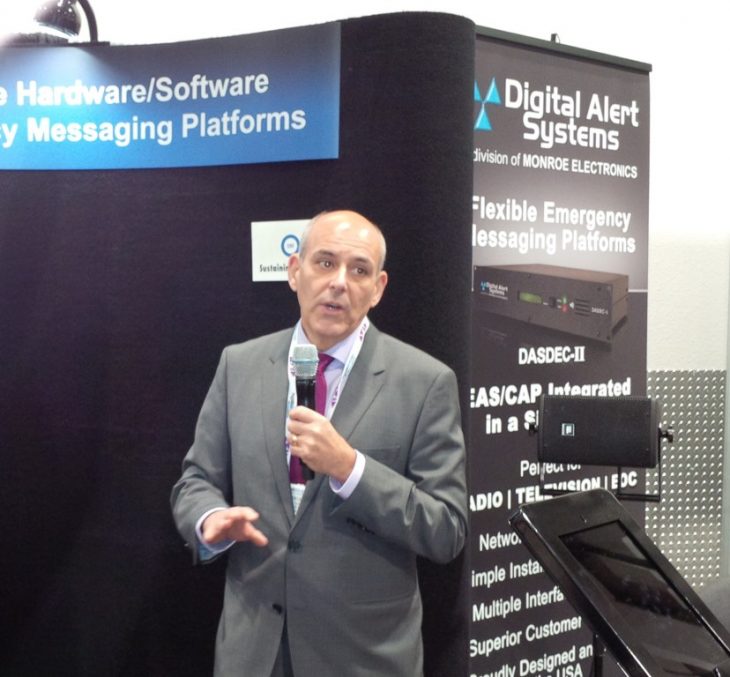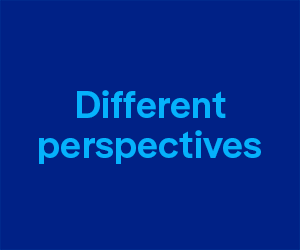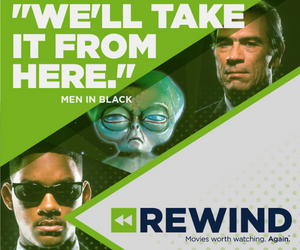
LAS VEGAS – It’s a big, big show and we can’t see or hear everything, nor turn everything into a full-sized story, so what you’ll see below is the good stuff we shook out of our notebook on the day before the 2013 NAB Show closes.
********************
AS BIG AS THE NAB Show and the broadcasting industry is in the United States, investment banker Josh Stinehour of Silverwood Partners put the industry in a bit better perspective during a session on the strategy and valuation of the media business by comparing it to another huge Las Vegas show held just over three months ago – the Consumer Electronics Expo. While the shows cover somewhat similar (large) spaces, the companies at NAB are a $25 billion market, he said, where CES is approximately a $1 trillion market. Guess which side wins in a fight. He didn’t say, but we think Stinehour meant that consumers will prevail when it comes to the future of media.
********************
THE 8K VIDEO PRESENTATION at the Japan broadcaster NHK booth was nothing short of spectacular. The video and audio quality of what it called Super Hi-Vision was stunning and one couldn’t help but think that this type of image quality will all but render 3DTV a curiosity. The image is that good, and no one needs special glasses. However, the bandwidth requirements for 8K (let alone 4K, which is just at the very beginnings of being deployed. Heck, some are barely used to the regular HD world) are equally stunning.
While HD might be 1080p and 4K, 2160p, 8K is 4320p. In the demonstration live broadcast in the NHK booth, they were using two 6 MHz channels to transmit a signal compressed to 182 Mbps, said a company rep. An uncompressed 8K signal runs at 24 Gbps. It’s 16 times the resolution of HD on the visual side and if you think Dolby 5.1 sound is killer, wait until you hear Super Hi-Vision’s 22.2 channel sound. Like we said, incredible.
********************
PELMOREX, OWNERS OF The Weather Network and MétéoMédia, could be found at two booths on the convention floor. Tucked deep within the lower South Hall was the company’s Beat The Traffic booth. Pelmorex bought the Santa Clara, Calif., company last fall and has integrated the real-time broadcast traffic tech into its on-air presentations. Beat The Traffic has been deployed in 60 stations around the world, including CP24 and CTV, many U.S. stations and overseas.

The Canadian broadcaster was also featured by Digital Alert Systems, which provides the broadcast technology for The Weather Network’s and MétéoMédia’s emergency alert service. DAS tech powers the Pelmorex-created National Alert Aggregation and Dissemination (NAAD) system. While the CRTC is solidly behind the system and Pelmorex has deployed it in its network, opting into the system is voluntary for Canadian broadcasters. This is far different than the States, where emergency alerts are mandatory and so broadcasters must install and test all the right gear. However, no Canadian broadcasters have chosen to take part in the Canadian NAAD system – which would come at the cost of about $3,000 per DAS box at each transmitter site. At right, Pelmorex’s Paul Temple helps with the demo on Monday.
********************
TUESDAY’S OPENING GENERAL session was a cordial (with underlying notes of tension) chat between Verizon CEO Lowell McAdam and NAB president and CEO Gordon Smith. The wireless CEO was blunt in his assessment of a number of things near and dear to broadcasters hearts.
McAdam noted, for example, how the wireless side of the company pulled apart its wireless service bundles in order to be more flexible and customer friendly and wondered why that shouldn’t be experimented with on the TV side. With five million FiOS TV customers, Verizon is the fifth-largest TV distributor in the States now. “We take a look at how many people are watching particular channels and it might be in the 100s kind of range,” he said. “There is some pressure from customers now about ‘why do I have to have 300 channels when I really only watch, well, pick a number,’… The idea I think worth considering is we can easily track how much a customer watches a channel and we work out together what (the price should be)… this isn’t a reduced cost from our perspective, it’s a reduced cost from the customer’s perspective and I think that’s a novel way to protect subscriptions in the long run.”
Verizon and the NFL announced a deal back in January where the big wireless company will let its subscribers watch the Super Bowl on their phones. So does that mean Verizon wants to unseat TV broadcasters from being the Super Bowl (or other big events’) rights holders? “We saw that there would be very specific needs for video streaming so about two years ago and started working with our technology providers and now if you all want to watch the Super Bowl, I can just put one channel up and every one of you will be able to tune to that channel,” he added, saying the traditional one-to-one streaming of such an event would exhaust all cell towers.
“It’s not our intent to get in the way of the broadcasters; 99-point however many 9s you want are going to be sitting at home in front of their big screen 4K TV or whatever,” he said.
When it came to offering FM radio on smartphones, while broadcasters would love it, no wireless customers are asking for it, said McAdam. “We do have phones that have FM chips in them, so this isn’t a religious issue for us but it looks to me that the trend clearly among the younger folks is towards customizing their radio stations and getting the streaming they want… What I have to do is give customers what they want… but I don’t get customers asking for that a lot… FM, whether it’s on the phone or not, is a very small issue for customers and they’re not speaking very loudly about it.”
*******************
IROQUOIS, ONTARIO’S ROSS VIDEO has been growing steadily for the past number of years, adding products and buying companies and now have one of the largest booths on the NAB Show floor in order to house all that they offer. Company CEO David Ross proudly showed us around the booth, including its Furio line of robotic camera systems (which are now a staple of the BBC News studio as five of the cameras populate the anchor desk, giving a Hollywood-like appearance of effortless motion, said Ross, even though the anchor is mostly seated). The Furios are so sleek and cool though they are even often pictured in live shots.

Ross (pictured in his booth beside the virtual sports set) was quite excited about being able to provide a brand new way to do TV production – and it won’t cost broadcasters using its production switchers any more money. Its Dashboard PanelBuilder is a touch-screen, fully customizable innovation. It hasn’t been fully released yet, as the company seeks more feedback, but it will mean that the big production switching board can be essentially put on any touch screen – and it is flexible enough for the broadcasters to create what they want themselves and customize it for each show. Now, instead of searching for buttons, operators only have to touch the video image on a screen or drag and drop to make the magic happen on TV. “We think this redefines how (the broadcasters’) operators interact with the equipment and create the on-air product,” Ross said.
********************
DIGITAL ASSET MANAGEMENT company evolphin announced that Astral Media decided to standardize on its Zoom product for managing all digital content. Astral selected Zoom, in part, to help its employees manage retrieval of files from its increasingly complex library of millions of television and related video files, said the company. Montreal-based Astral Media produces dozens of video promos per week, and has seen its content library grow to more than one million files, meaning it’s a content library of over 40TB
********************
TORONTO’S DIGITAL RAPIDS showcased a growing roster of industry partnerships for its well regarded Kayak dynamic workflow platform. New partners highlighting Kayak include Dell, as part of its ne new Dell Create multi-vendor workflow solution; Dolby Laboratories; Microsoft, where Kayak-powered media processors for Windows Azure Media Services are being featured; Ross Video; Vanguard Video; and Venera Technologies.
********************
WATERLOO’S OPENTEXT was demonstrating its Digital Asset Management managed file transfer systems for broadcasters on the NAB floor. Its six step demo guide detailed a step-by-step process from project planning to collect and capture to video editor to graphics to the review process and the publish and multichannel distribution. The company’s DAM provides what it calls a “single source of truth” for branding, packaging, and global distribution of video and other media assets.
Yup, it's a big show…




